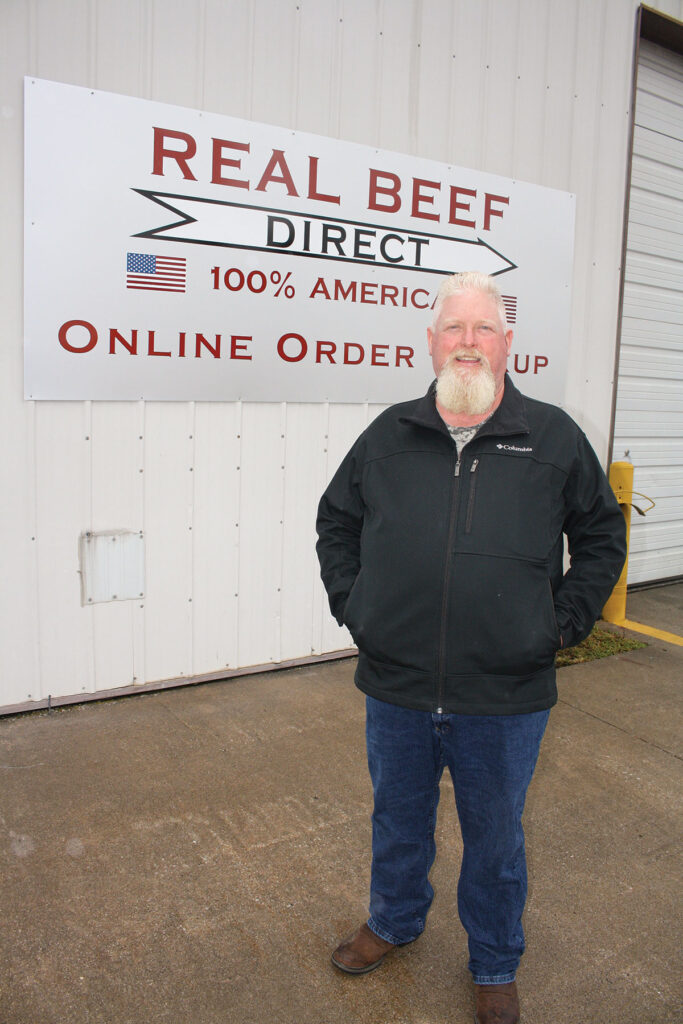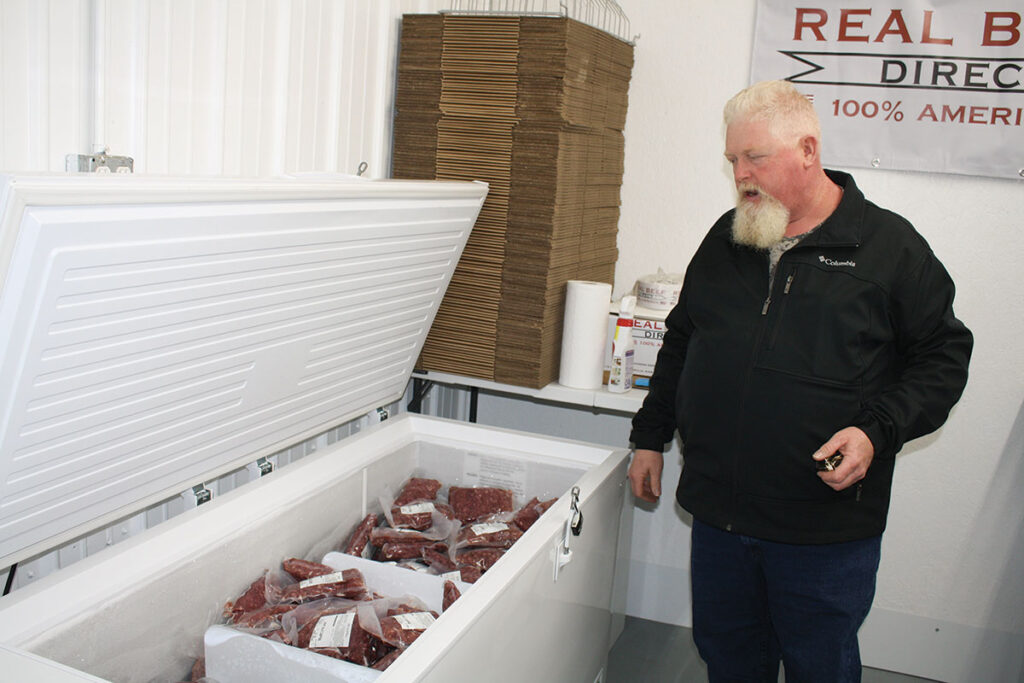
Scott Bass launches new venture with e-commerce and the 24/7 accessibility of beef
ROGERSVILLE, MO. – Scott Bass is no stranger to the cattle business. He’s a fourth-generation cattleman in Webster County, Mo., near Rogersville, farming some of the land that has been a part of the family for more than 100 years.
Scott has been offering custom-fed beef to customers since high school, and he planned on being a dairy farmer once he graduated. After a few years, however, Scott liquidated his 120-cow herd and began focusing on his cow/calf operation.
Scott and his late father Gene started Bass Premium Beef in 2001, offering wholesale beef, but as times changed, so did Scott’s beef operation.
“You have to adjust,” Scott said. “Just being old-school and set in your ways isn’t going to do it anymore. I try to see the opportunity in things.”
Scott, who also owns Bass Livestock Nutrition, launched a new venture with Real Beef Direct this summer. Real Beef Direct allows customers to buy and pick up beef from cattle raised on the Bass family farm and processed at local facilities, 24/7.
“When the fake meat deal started gaining traction in around early 2020, a lot of groups jumped onto that bandwagon for their interests, like PETA, climate change groups, and those looking for a cheap protein source,” Scott said. “Also, feeder calf prices we very venerable, so I decided to do the retail beef cuts. I felt we had a very good opportunity to do this with the facilities we have and the infrastructure that has been put together over the years.”
Scott also said issues with the country’s “big four” meat packers regarding supply chains and consumer pricing prompted the endeavor.
“We have to be able to get our end product out at a marketable price,” he said. “I’ve thought about this for a long time and said ‘I’m in.’”
Scott turned to e-commerce for retail sales for Real Beef Direct and looked to his oldest son Parker to set up online ordering and payment.
Once the order is placed, beef is packaged and customers come to the Bass farm to pick up their order, using their unique code to enter a secure freezer area.

“The easy part of this whole deal is the online ordering,” Scott said of the Real Beef Direct website. “We are open 24/7, 365 days a year. I told someone our overhead is so low I can hit my head. I have a secure facility, safe for the public to come to the farm, and it is simple. Without the online presence, this would not have been possible. We’re just using technology that’s available today to market our product.”
Customers may not have the convenience of grabbing something from the meat case on the way home, but Scott said Real Beef Direct offers something big retailers can’t.
“If you ask a guy at the counter where it came from, they can’t tell you,” Scott said. “I don’t think it’s the deciding factor, but it’s more important to serious buyers, that’s someone who is putting some thought into what they are buying. We have a fresh product with no antibiotics, no hormones, and source-verified because they are born and raised here. We plan the genetics of these calves, so it goes from conception of the calf to the finished beef.”
Calves are raised on grass, backgrounded at the Bass farm, and then offered grain for 120 days before processing.
“The only thing we aren’t doing for these cattle is raising the grain,” Scott said. “We did for a few years, but when corn gets below $4 a bushel, I’m better off to buy it. We feed a distiller’s grain corn-based ration with forages. We graze a lot and put up a lot of hay.”
Real Beef Direct strives to keep prices for their beef lower than those in the grocery store.
“When meat prices get high, I don’t want to capitalize on it; I don’t want to do that to the consumer,” Scott explained. “I want a moderate margin on the animal coming through and selling the consumer a valuable product at a reasonable price. No one should have to go to the store and pay what they are paying now. There’s too much margin in the feedlot price paid for the fats and what’s being paid in the store. I don’t have a goal of how many calves I’m going to do, but I would like to run as many calves through Real Beef Direct as possible; the more, the better. I want to build a clientele over the years, and I would like my two sons, Parker and Preston, to pursue this as well.”
Real Beef Direct is a portion of his operation, but Scott said his cow/calf operation continues to be the main focus because, without those cows, there wouldn’t be any beef sales. He has been very selective over the years with his genetics, choosing structure and longevity over EPDs in many cases.
“When meat prices get high, I don’t want to capitalize on it; I don’t want to do that to the consumer. I want a moderate margin on the animal coming through and selling the consumer a valuable product at a reasonable price.”
— Scott Bass
“I’m kind of old school; I look at the phenotype, the functionality,” Scott said. “They have to have a good foundation of feet and legs, good udders and reproduce. Cows are like employees. A cow that doesn’t produce is like an employee who doesn’t work; you can’t afford them. We take care of them, but we aren’t working for them.”
The Bass herd is Angus and Hereford-based, which produces the type of cattle Scott likes and appreciates.
“Our herd is a lot of white-faced cattle, black baldies and red baldies,” Scott explained. “What I did over the years was build a seedstock base, so I have my own genetics. I’ve always said those cattle will stay fat on a rock. My herd is a more moderate size and is more efficient with the feed we have here in the Ozarks. A lot of the beef I finish will be in that 1,100-pound range, maybe up to 1,200. I have done that because I feel those cattle are the most efficient on what they can gain on grass.”
Scott hopes to cycle between 75 to 100 calves through his freezers within his first year in business.
“That’s kind of conservative, but it all depends on what happens in the next six months,” he said. “We may run pretty good, then slow down; I don’t know because it is so new. A year from now, I will have an idea of what we’ve done, and we can try to put a growth projection on it. We’ll have variations on orders, but we missed the big grilling season. This thing is so new, we have no data, but if we can get in the first year and have that many cattle ran through it, I will be tickled to death.”
In addition to cattle going into the Real Beef Direct meat program, Scott said they continue to sell wholes and calves to customers, and selling calves on the open market.
“We always save some replacements and market the steers and heifers through feeder markets. We also retain so many to keep and finish out,” Scott explained, adding because he does finish animals for the open market, he can easily add animals for beef sales.
Marketing for the Bass operation and Real Beef Direct continues to evolve. Scott hopes to develop databases to help customers track what they order most and work with other companies to provide employee incentives or bonus boxes.
“It’s better than a fruit cake,” Scott said.
Further down the road, Scott also hopes to begin shipping beef, but logistics and cost are significant factors at this point.
He also encourages other producers to begin looking at new ways to market their farm-fresh, local beef to customers in the Ozarks.
“There’s room for us all in this,” Scott said of other beef producers. “Our biggest competition is the big four meatpackers. Getting a direct line to the consumer helps keep us in business, and consumers know where they can get a good product.”







